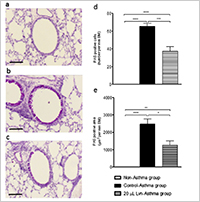Enlarge Image
Lavender oil may offer a new treatment for murine models of allergic asthma
In studies using mice researchers at Okayama University demonstrate the therapeutic effects of lavender essential for treating asthma.
Asthma affects over 200 million people worldwide and can be fatal. The condition is characterised by shortness of breath, often in response to allergens. Once triggered, the production of inflammatory cytokines and mucins - gel-forming mucos glycoproteins - leads to obstruction, hyperresponsiveness and inflammation of the airways. Evidence of beneficial effects from lavender essential oil (Lvn) on other immune responses prompted Tomoe Ueno-Iio, Misako Shibakura and colleagues at Okayama University and Okayama University Graduate School of medicine to examine the effect of Lvn on a mouse model of acute asthma.
The researchers used ovalbumin to artificially induce asthma in mice, with some were exposed to to Lvn, others weren’t, and a non-asthma control was not treated with ovalbumin. They characterised the resulting symptoms by monitoring lung resistance and examining both the cells found in fluid washed from the lungs (Bronchoalveolar lavage, BAL) and lung tissue. Ueno-lio, Shibakura and colleagues observed a reduction in cytokine levels in BAL fluids and their mRNA expression, as well as a decrease in one of the mucins secreted most in the respiratory tract, Muc5b.
The researchers highlight that one of the main components of Lvn is linalyl acetate, which previous research by other groups has been shown to inhibit NF-κB in human cancer cells. NF-κB is also known to be activated to produce the gene for the Muc5b. Significantly Muc5b was inhibited in the mice exposed to Lvn but not another highly secreted mucin, Muc5ac, which is not regulated by NF-κB. The T-helper-2 cells that produce the key cytokines (IL)-4, IL-5 and IL-13 involved in airway inflammation are also regulated by NF-κB, and were found to be inhibited by exposure to Lvn.
They conclude in their report, “Our results present a new role for this essential oil in allergic airway inflammation and mucous cell hyperplasia. But we need further studies if we want to apply these findings to humans because they may only be applicable to mice at this moment.”
Note
The effects of NF-κB were verified in research by other groups and not Tomoe Ueno-Iio.
Publication and Affiliation
Tomoe Ueno-Iio1, Misako Shibakura1,*, Kanayo Yokota1,Michinori Aoe1, Tomoko Hyoda1, Ryoko Shinohata1, Arihiko Kanehiro2, Mitsune Tanimoto2, Mikio Kataoka1 Lavender essential oil inhalation suppresses allergic airway inflammation and mucous cell hyperplasia in a murine model of asthma. 2014 Life Sciences 108 109-115.
- Field of Medical Technology, Okayama University Graduate School of Health Sciences, Okayama, Japan
- Department of Haematology, Oncology, Allergy, and Respiratory Medicine, Okayama University Graduate School of Medicine, Dentistry, Pharmaceutical Sciences, Okayama, Japan
*corresponding author, e-mail address: m_shiba@md.okayama-u.ac.jp

